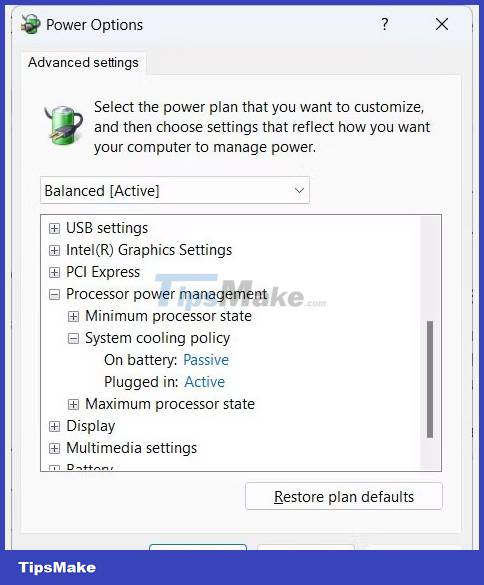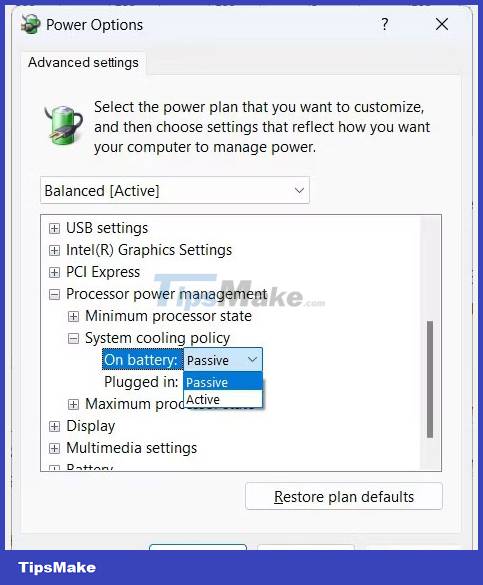What is System Cooling Policy on Windows? How to set up?
To keep things cool, your computer needs to maintain a good balance between fan and processor speeds. And that's where the System Cooling Policy comes in.
Today's article will discuss what System Cooling Policy is and how to set it up to best suit your Windows PC.
What is System Cooling Policy Windows?

System Cooling Policy is a set of profiles that help keep the internal temperature of your Windows computer cool by automatically adjusting the CPU clock speed and PC fan speed. When the computer is doing something processor intensive and you hear your PC's fan start to spin louder, that's the System Cooling Policy at work.
There are two options when installing System Cooling Policy: Active and Passive. Active Cooling Policy makes the fan run faster before slowing down the processor. Meanwhile, Passive does the opposite – making the processor slower before speeding up the fan.
The policy you set up will depend on what you want to prioritize: Performance or power. So, for example, if you want to save battery life on your laptop, you might want to implement a Passive Cooling Policy.
How to set up System Cooling Policy on Windows
To set up a system policy, start by opening the Control Panel. Press Win + S to open Windows Search, type control panel in the text box, and click Control Panel in the results.
Next, go to Hardware and Sound > Power Options , then click Change plan settings next to the power plan you're using.

Click Change advanced power settings to open the Power Options menu.

Expand Processor power management by clicking the plus sign on the right and you will see System Cooling Policy. Expand it too.

You will then see how to set up the cooling policies – of course, what you see will depend on whether you are using a desktop or laptop computer. To change them, click the cooling policy link – so if On battery is set to Passive , click Passive. This will turn it into a drop-down list, so click that and choose another cooling policy.

You can set up a cooling policy for all your power plans. And if you're changing your cooling policy to save battery, consider reading TipsMake's guide on how to create a custom power plan on Windows.
Remember, Active Cooling Policy prioritizes performance, while Passive Cooling Policy prioritizes battery consumption. You can change the policy as often as needed in the advanced power settings for your favorite power plans.
You should read it
- Use Group Policy Filtering to create a NAP DHCP enforcement policy - Part 1
- How to reset Local Group Policy settings on Windows 10
- Use Group Policy Filtering to create a DHCP enforcement policy for NAP - Part 2
- Install the printer using Group Policy Object
- How does the radiator on the phone work?
- Install water cooling system for computers
- How to Enable and Use Script Execution Policy in Windows PowerShell
- Decode the super exclusive cooling fan design from the world famous graphics card brands
May be interested
- Install the printer using Group Policy Object
 in the following article, we will show you how to install the printer using group policy object. in essence, this process is not too complicated and difficult, but just follow the process. first, open the group policy control panel, edit the policy m & agra component directly
in the following article, we will show you how to install the printer using group policy object. in essence, this process is not too complicated and difficult, but just follow the process. first, open the group policy control panel, edit the policy m & agra component directly - System Administration with Group Policy in Windows XP - Part I
 in windows xp there is a nice tool, group policy (gp). many windows users have been around for a long time but have never known this tool because they cannot be found in control panel, administrative tools or system tools. gp is one of the components of microsoft management console and you must be a member of the group
in windows xp there is a nice tool, group policy (gp). many windows users have been around for a long time but have never known this tool because they cannot be found in control panel, administrative tools or system tools. gp is one of the components of microsoft management console and you must be a member of the group - Are cooling pads effective? How to use a laptop cooling pad extremely quickly
 are cooling pads effective? how to use a laptop cooling pad in detail and correctly to ensure long-term machine life.
are cooling pads effective? how to use a laptop cooling pad in detail and correctly to ensure long-term machine life. - 4 tips to open Local Group Policy Editor on Windows 8 / 8.1
 in the local group policy editor, you can set the deletion of the notification history, set up the account lock to limit the number of logins, etc. in the article below, network administrator will show you 4 ways to open. local group policy editor on windows 8 and windows 8.1.
in the local group policy editor, you can set the deletion of the notification history, set up the account lock to limit the number of logins, etc. in the article below, network administrator will show you 4 ways to open. local group policy editor on windows 8 and windows 8.1. - 9 Ways to Open Local Group Policy Editor on Windows 11
 on local group policy editor, you can set up to delete notification history, set up account lock to limit the number of logins, etc. in the article below, tipsmake.com.com will introduce you to some ways to open local group policy editor on windows.
on local group policy editor, you can set up to delete notification history, set up account lock to limit the number of logins, etc. in the article below, tipsmake.com.com will introduce you to some ways to open local group policy editor on windows. - Which cooling pad should I buy for my laptop? Which cooling pad is best?
 which cooling pad should i buy for my laptop? which cooling pad is best to ensure the usage capacity and prolong the life of my laptop?
which cooling pad should i buy for my laptop? which cooling pad is best to ensure the usage capacity and prolong the life of my laptop? - Mount Network Drive on Windows Client using Group Policy
 the job of mapping network drives is one of the most commonly done tasks of system administrators, this process was often done by scripting. in the following article, we will show you how to do this via group policy in windows ...
the job of mapping network drives is one of the most commonly done tasks of system administrators, this process was often done by scripting. in the following article, we will show you how to do this via group policy in windows ... - Basic instructions on how to properly remove and install a CPU cooling fan
 the cooling fan helps keep the cpu temperature stable. let's learn how to remove and install the cpu cooling fan most effectively.
the cooling fan helps keep the cpu temperature stable. let's learn how to remove and install the cpu cooling fan most effectively. - Use Group Policy Filtering to create a DHCP enforcement policy for NAP - Part 3
 in this part 3, i will show you more about policies and see what they do in a dhcp enforcement solution.
in this part 3, i will show you more about policies and see what they do in a dhcp enforcement solution. - How does the radiator on the phone work?
 the stronger the phone, the more heat it emits. to keep the device cool, many phones have the ability to dissipate heat with water. what are they and how do they work?
the stronger the phone, the more heat it emits. to keep the device cool, many phones have the ability to dissipate heat with water. what are they and how do they work?










 What is ViVeTool? How to use ViVeTool to enable hidden features on Windows
What is ViVeTool? How to use ViVeTool to enable hidden features on Windows Learn about DDR6 RAM
Learn about DDR6 RAM Is Google DNS or Cloudflare DNS faster?
Is Google DNS or Cloudflare DNS faster? How to hide MAC address? Why should this be done?
How to hide MAC address? Why should this be done? 7 methods to fix NSIS 'Make Sure Your Temp Folder Is Valid' error
7 methods to fix NSIS 'Make Sure Your Temp Folder Is Valid' error How to add full battery charge notification for Windows 10/11
How to add full battery charge notification for Windows 10/11